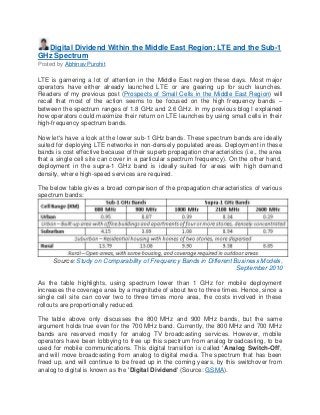
Digital Dividend Within the Middle East Region: LTE and the Sub-1 GHz Spectrum
- 1. Digital Dividend Within the Middle East Region: LTE and the Sub-1 GHz Spectrum Posted by Abhinav Purohit LTE is garnering a lot of attention in the Middle East region these days. Most major operators have either already launched LTE or are gearing up for such launches. Readers of my previous post (Prospects of Small Cells in the Middle East Region) will recall that most of the action seems to be focused on the high frequency bands – between the spectrum ranges of 1.8 GHz and 2.6 GHz. In my previous blog I explained how operators could maximize their return on LTE launches by using small cells in their high-frequency spectrum bands. Now let's have a look at the lower sub-1 GHz bands. These spectrum bands are ideally suited for deploying LTE networks in non-densely populated areas. Deployment in these bands is cost effective because of their superb propagation characteristics (i.e., the area that a single cell site can cover in a particular spectrum frequency). On the other hand, deployment in the supra-1 GHz band is ideally suited for areas with high demand density, where high-speed services are required. The below table gives a broad comparison of the propagation characteristics of various spectrum bands: Source: Study on Comparability of Frequency Bands in Different Business Models, September 2010 As the table highlights, using spectrum lower than 1 GHz for mobile deployment increases the coverage area by a magnitude of about two to three times. Hence, since a single cell site can cover two to three times more area, the costs involved in these rollouts are proportionally reduced. The table above only discusses the 800 MHz and 900 MHz bands, but the same argument holds true even for the 700 MHz band. Currently, the 800 MHz and 700 MHz bands are reserved mostly for analog TV broadcasting services. However, mobile operators have been lobbying to free up this spectrum from analog broadcasting, to be used for mobile communications. This digital transition is called 'Analog Switch-Off', and will move broadcasting from analog to digital media. The spectrum that has been freed up, and will continue to be freed up in the coming years, by this switchover from analog to digital is known as the 'Digital Dividend' (Source: GSMA).
- 2. Mobile operators in the Middle East have been particularly active in promoting the analog switch-off in the region. The World Radiocommunication Conferences (WRC) of International Telecommunication Union (ITU) makes the decisions regarding allocation of radio-frequency spectrum for telecom operators. During the 2012 edition of the conference (WRC-12), a decision was taken to allow the opening up of the 700 MHz band for mobile operators in Europe, the Middle East, and Africa (collectively called as 'Region 1'). The Middle East and Africa operators were allowed to use this spectrum immediately, while those in Europe were to wait till 2015 before accessing the 700 MHz band. Interestingly, this band is already open for mobile operators in the rest of the world – Region 2 (Americas) and Region 3 (Asia and Australasia). The decision on Region 1 was taken primarily due to strong lobbying by Middle East and Africa representatives at the conference (Source:Total Telecom). The availability of the 700 MHz spectrum for mobile will go a long way towards removing some of the major hurdles towards LTE mass adoption. Firstly, with all regions having LTE options in the 700 MHz range, roaming while on LTE will be harmonized and made possible. Currently most LTE roaming is supported via 3G fallback. Further, with a harmonized spectrum, the device ecosystem would also get a boost, with new LTE devices working across the globe; a much-needed change from the current setup where devices supporting LTE in North America will not do so while roaming in the Middle East. I have discussed these issues in much more detail in one of my recent IDC reports (LTE in Saudi Arabia, the UAE, and Qatar: 2011–2012 Market Analysis and 2013–2017 Forecast, July 2013). Now that the framework is in place, the onus lies with the individual countries and their telecom regulators to take steps towards freeing up the 700 MHz spectrum. The success of WRC-12's announcements will depend on how quickly they can be implemented, so that all the regional operators move to a mutually agreeable 700 MHz band plan. We have already started to witness some pioneering moves in this respect. Following WRC-12, in May 2012, the Telecommunications Regulatory Authority (TRA) of the United Arab Emirates (UAE) announced plans to vacate sub-1 GHz spectrum for use by mobile operators in the county. As per the proposed plan, the TRA will make spectrum in the 694–862 MHz band available by 2015. The TRA is vacating these bands from the analog TV broadcasting operators to implement the 'Terrestrial Digital TV Switchover' plan, which is scheduled to be completed by the end of 2013. The TRA is among the first regulators in the region to propose an additional allocation for mobile operators in the 700 MHz band. The move has been welcomed by all stakeholders in the country's telecom ecosystem. Following the UAE example, more countries in the region are expected to announce such analog switch-off plans. This will build a strong base for a harmonized 700 MHz LTE spectrum plan for the region and allow for much better integration with the global LTE rollout plans.
- 3. The stage is truly being set for a massive LTE growth plan across the region… Follow Abhinav Purohit on Twitter @PurohitAbhinav. For all other blog posts written by Abhinav Purohit, visit Abhinav Purohit's Community Profile Page. For more discussions and topics around SP Mobility, please visit our Mobility Community: http://cisco.com/go/mobilitycommunity
